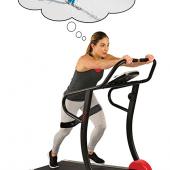Heal the Hurt
The hard truth about soft-tissue injury.
Anyone who has spent time recreating in the Gallatin Valley has likely suffered the symptoms of soft-tissue injury in one form or another. It comes with the territory. By and large, the most common soft-tissue injuries are contusions, strains, and muscle soreness.
A contusion (bruise) is due to a sudden, traumatic compressive force to a body part. Depending on the amount of force, there may be superficial or deep-tissue bleeding and damage. This bleeding typically forms a blood clot, or hematoma, and may result in skin discoloration. The area is tender to touch and may hurt to use. Most contusions resolve themselves within five to seven days. However, deep contusions of the thigh are quite painful and can develop into something more severe. If you have an extremely painful thigh contusion that swells immediately and is too painful to bear weight on, consult a trainer, therapist, or physician immediately.
A severe stretch or tension force on a muscle group causes a strain. Depending on the strength of the force and the susceptibility of the muscle itself, this may result in a small or large tear in the muscle or adjacent tissues. Because the muscle has been damaged, bleeding typically occurs, causing swelling. This swelling usually results in muscle stiffness and pain. It can be painful to touch or use the injured muscle group; the pain may be immediate or delayed. If the injury is so severe that you’ve lost function entirely, consult a trainer, therapist, or physician to ensure that the muscle has not completely torn.
Most strains are minor and only involve small tears in the muscle, such that you maintain function, albeit with minor pain. These injuries may not appear impressive on the surface, but can take anywhere from seven days to four weeks to fully recover. Give muscle strains time to heal; any re-injury will only prolong your recovery. A good rule of thumb is to use pain as your guide: if it hurts, you’re overdoing it.
Muscle soreness typically falls into one of two categories: immediate or delayed. An example of immediate muscle soreness would be a skier whose thighs “burn” toward the bottom of a long bump run but then recover on the chairlift ride back to the top. Immediate muscle soreness is due to muscle fatigue. An example of Delayed Onset Muscle Soreness (DOMS) would be the skier who goes home feeling fine, but wakes up “sore” the next morning. DOMS is believed to result from lactic acid buildup as well as “micro tears” in the muscle fibers. DOMS usually sets in 12 to 24 hours after the intense muscular exercise and resolves within three to four days. The muscles may be sore to touch and painful to use, leading to stiffness. However, aside from the discomfort, immediate muscle soreness and DOMS rarely lead to anything serious. It can, however, affect your recreational plans if you only have three days to ski!
The bottom line with most soft-tissue injuries is that they will likely resolve on their own given time. Many athletes seek to shorten the healing time so that they can return to their sport as soon as possible. While the body must go through a natural healing process, you can take steps to hasten your recovery.
Before we review these steps, it helps to understand the natural healing process. Tissue progresses through three phases in response to injury: inflammation, repair, and remodel. In the first phase, cellular injury occurs, causing a localized reaction characterized by redness, swelling, tenderness, pain, warmth, and in some cases, loss of function. During the repair phase, symptoms of inflammation subside and a scar begins to form. This scar is weak until the remodeling phase, when the scar matures and strengthens. Progressing through all three phases can take up to six weeks or longer depending on the extent and type of injury. That doesn’t mean you have to wait the full six weeks before returning to your sport safely. However, while you may feel great skiing again, you should be aware of the heightened risk of re-injury during this time.
Now that you know more about how tissues heal, you can understand why doctors treat soft-tissue injuries as they do. You’ve probably already heard our favorite acronym, RICE, which stands for (Relative) Rest, Ice, Compression, and Elevation. For the most part, our body’s natural healing response is appropriate. However, the bleeding and swelling component of the inflammatory phase can be excessive and lead to additional tissue damage. Moderating this aspect of the inflammatory response is the area initial treatments target.
(Relative) Rest highlights the fact that injuries need time to heal. It doesn’t mean you should crash on the couch or lay in bed for days; thus the inclusion of the term “Relative.” Staying active and loose while resting only the injured part prevents stiffness and will help you return to your sport sooner. For example, if you injure your groin while telemark skiing, you might try cycling to stay loose and work other healthy muscles while your groin heals. Cross-training effectively provides “Relative Rest.”
Ice and other forms of cold therapy are effective at minimizing the amount of swelling. Cold therapy is most effective early on, before swelling has settled in and has the added advantage of providing some pain relief. It’s a cheap and effective multi-purpose treatment (be careful not to overexpose bare skin to extreme cold; try using a protective barrier like a dish towel to diminish this risk).
Compression typically comes in the form of ACE-type bandages and also helps minimize swelling. By compressing the affected area, there is less room for the tissues to accommodate swelling, which limits bleeding deep in the tissue. For some athletes, added advantages of compression include a sense of stability and heightened body awareness of the injury.
Elevation also helps minimize swelling. Ideally, elevate the injured extremity above the level of the heart for frequent intervals during the first 48 hours after the injury.
Beyond RICE
In addition to the RICE treatments, there are some clinically proven (and unproven) measures you can utilize to help manage the pain associated with soft-tissue injuries, minimize the swelling, and reduce time away from your sport.
Over-the-counter anti-inflammatory medications and creams can be very beneficial. Examples include aspirin, ibuprofen, and Naproxen, as well as capsaicin and menthol-based creams. In addition to their anti-inflammatory properties, they also provide significant pain relief. Arnica, Traumeel, and Tiger Balm are three well-known topical herbal alternatives.
Non-pharmacologic therapies can also be considered. These include therapeutic exercise, ultrasound, electrical therapy, massage, acupuncture, acupressure/Shiatsu, yoga, and Pilates, among others. The first three are typically first administered by a certified physical therapist. Then, depending on your level of comfort, they may be self-administered. The latter interventions have yet to be proven effective in the medical community, but have low-risk profiles, and so are worth a try. I know that massage works for me!
The timing of applying the above therapies is important. Don’t jump into an aggressive therapy session or 90-minute deep massage immediately after the injury. Give the injury a day or so (while utilizing RICE treatments) before getting aggressive with rehabilitation. This is to avoid potentially extending the injury or causing further discomfort. The cliché “No Pain, No Gain” definitely does not apply to soft-tissue injury rehabilitation. If what you do hurts the injured area, back off and try something different. As long as you stay active and give your injury the appropriate amount of “respect,” you will return to your sport successfully and safely.
Erica Livia Peterson, M.D., is board-certified in family medicine and sports medicine.










